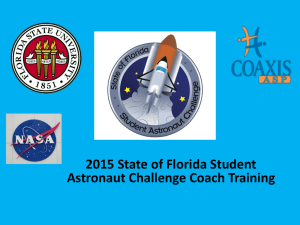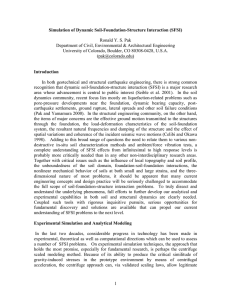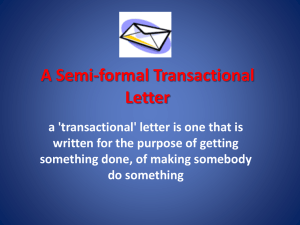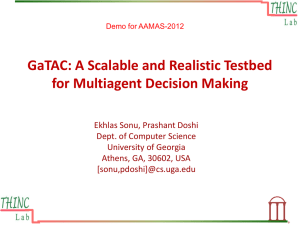Space Flight Simulator Instructional System
advertisement
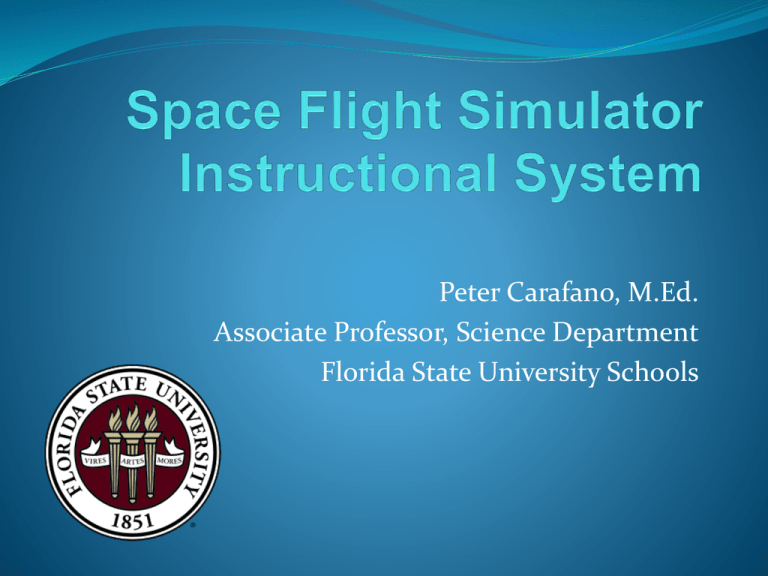
Peter Carafano, M.Ed. Associate Professor, Science Department Florida State University Schools The Origin of SFSI The space flight simulator instructional system (SFSI) was developed through a grant research project funded by the Florida Department of Education. The grant was awarded to the Science Department at Florida State University Schools The focus of the grant was to develop two systems: A classroom based system that could be easily replicated by science teachers in Florida A mobile space flight system which could be used throughout the state to promote STEM FSUS Mobile Space Flight Simulator Cockpit FSUS Mission Control Training Center Cloned Monitors Being Used In Mission Control Program Goal Foster student interest in Science, Technology, Engineering and Math (STEM) Improve problem solving and critical thinking skills Provide for team building Demonstrate the practical application of math and science Take advantage of virtual immersion to foster student engagement System Concept Patterned after flight simulators and their use to train pilots and astronauts. System Concept Provide a flexible simulation system that was not overly complicated but still required student effort for mastery. A simple, inexpensive system that could be easily incorporated in the classroom with minimal resources. A system that could be modified by the instructor as needed. Necessary software required to operate the program could be obtained for free. Minimum Required Equipment Three to four computers or laptops with the the ability to run PowerPoint A flight joystick Orbiter flight program SFSI PowerPoint multi-function display presentations Reference material Shuttle switch control panels Flight operational checklists and emergency procedures checklists Basic Classroom Simulator Setup With Cloned Monitors Commander Mission Specialist Mission Control Pilot SFSI Instructional system Students are divided into teams of five. Students practice performing flight operations using the procedure checklists. Students train using desk top practice sessions or the classroom simulator. Classroom Astronauts Three students are responsible for the operation of the space shuttle. Commander - They maneuver the space shuttle and are in charge of the orbiter. Pilot - They assist the Commander in controlling and operating the orbiter on a space mission. Mission Specialist. They are assigned the responsibility of reading off the pre-flight, in-flight and landing checklists. Classroom Astronauts Two students operate Mission Control. Monitor telemetry readouts of the shuttle systems and confirm telemetry information with the astronauts Monitor the flight checklist to ensure all steps are completed In the event of an Emergency, they help the shuttle crew identify the problem and then walk them through managing the problem using the Emergency Procedure checklist Teaching Critical Thinking The most important component of the SFSI system is: To help students learn how to problem solve in situations that reflect real life conditions Focus on the perspective that a team approach works the best Common Problems with Teaching Problem Solving Either one or several students will take charge and make all the decisions leaving some not involved in the process. The students will not thoroughly think through the problem and come up with a wrong answer. The group will become discouraged and give up and wait for the teacher to give them the “right answer”. The group will come up with “any answer” just so they can get finished and wait to hear what the “right answer” was. Basic Methods for Problem Management Understand the problem Create a plan to address the problem using a series of actionable steps Maintain motivation so you don't give up or get frustrated when it takes a while to successfully resolve the problem. Why Use Virtual Simulation? It’s All About Engagement! SFSI – A three step process Step 1 Have the students use the simulator to perform normal flight operations as a team. This process is practiceds as many times as possible so that they are used to working together and become confident in each other abilities. SFSI – A three step process Step 2 Give them simple emergency situations that they can solve using an emergency checklist. Have them practice various emergencies until they are comfortable working together. Practice the procedure of: 1. Evaluate the problem 2. Determine the cause 3. Agree on a course of action 4. Evaluate the results 5. Mange the problem SFSI – A three step process Third step Give them emergency situations that are not covered by the emergency checklist Have the emergency involve systems that they are familiar with. Have them use their understanding of how the systems work, to develop several steps to solve the problem and work together to mitigate the emergency How the Virtual System Works Simulator System The space flight simulator system consist of two separate programs. The “Orbiter” program which is run on the Mission Commander computer. SFSI PowerPoint multi-function display presentations which are separated into two systems The “Basic Control Panel Master” PowerPoint which is run on the Pilots computer The “Mission Specialist Panel” PowerPoint which is run on the Mission Specialist computer. Orbiter Orbiter is a freeware space flight simulator program developed to simulate spacecraft using a realistic flight model. It was developed by Martin Schweiger PhD The goal was to provide a simulators with realistic physics based flight models Orbiter has been used as a teaching aid in classrooms, and a community of add-on developers have created a multitude of expansion capabilities. Orbiter Windows 98/2000/XP/Vista/Win7 1.2 GHz Pentium or equivalent processor 512 MB system RAM DirectX 7 or newer DirectX compatible graphics card with 64 MB of memory Approx. 120 MB free hard disk space for minimum installation. Orbiter Orbiter (shuttle landing) Orbiter (shuttle orbit) SFSI PowerPoint Multi-function Displays PowerPoint Presentations which have been set up, using a standard format, to replicate a LCD cockpit display The PowerPoint screen are timed to coincide with the “Orbiters” Shuttle program once initiated They are completely editable and can be modified to provide various emergencies or system anomalies SFSI PowerPoint Multi-function Displays (Pilot) SFSI PowerPoint Multi-function Displays (Mission Spc.) SFSI PowerPoint Multi-function Displays An additional PowerPoint Presentations was developed for the Mission control team This provides additional information in the event “cloned” monitors are not available for use. SFSI PowerPoint Multi-function Displays (Mission Comtrol) Reference Material Space Flight Simulator Instructional System Guide Complete system operational instructions Orbiter program installation instructions Shuttle switch control panels Flight operation checklists Emergency procedure checklists Reference Material Space Flight Simulator Instructional System Guide Reference Material Directory Chapter 1 Space Simulator Instructional System page 3 Chapter 2 Shuttle Flight Team page 8 Chapter 3 Mission Control Team page 22 Chapter 4 Emergency Conditions page 25 Chapter 5 Instructor Recommendations Appendix page 30 A. Emergency Procedures page 31 B. Mission Check Lists page 47 C. Cockpit Normal Data screens page 67 D. Cockpit Control Switch Diagrams page 71 Glossary page 78 Reference Material Emergency Procedures PAYLOAD BAY – FROM OPEN PAYLOAD BAY – FROM CLOSED POSITION TO CLOSE POSITION TO OPEN 1. Alarm system -------- SILENCE 1. Alarm system -------- SILENCE 2. Notification of Mission Control -------- Confirm 2. Notification of Mission Control -------- Confirm 3. BAY DOOR LCK set to RELEASE - Confirm 3. BAY DOOR 4. BAY DOOR 4. BAY DOOR LCK -------- LOCK -------- OPEN -------- CLOSE 5. Re-assess system 5. Re-assess system 6. BAY DOOR 6. Bay Door -------- CLOSE -------- OPEN 7. Initiate Bay Door Close program 7. Initiate Bay Door Open program 8. Re-assess system 8. Re-assess system 11 Reference Material (The number identified next to a command represents the panel location) C – Commander P – Pilot M – Mission Specialist COM TIME PROCEDURE Notes 1 T -HOLD Test Left Pilot Audio COM Test Right Pilot Audio COM Test Left MSP Audio COM Advise: Communication System test with mission control STAN CABIN DOOR to CLOSE (2) CABIN DOOR LOCK to LATCH (2) Advise: Commander Confirms with Confirm BAY DOOR to CLOSE (2) mission control that the Side Hatch Confirm BAY DOOR LOCK to LATCH (2) Is Closed & Locked Confirm GEAR to UP (2) Confirm LANDING GEAR to DISABLE (2) Confirm CHUTE to DISARM (2) Confirm SPEED BRAKE to OFF (2) Start Launch Clock P - [space bar] Reference Material Reference Material Resource Access Astronaut Challenge Website Reference Material Section http://www.astronautchallenge.com/

